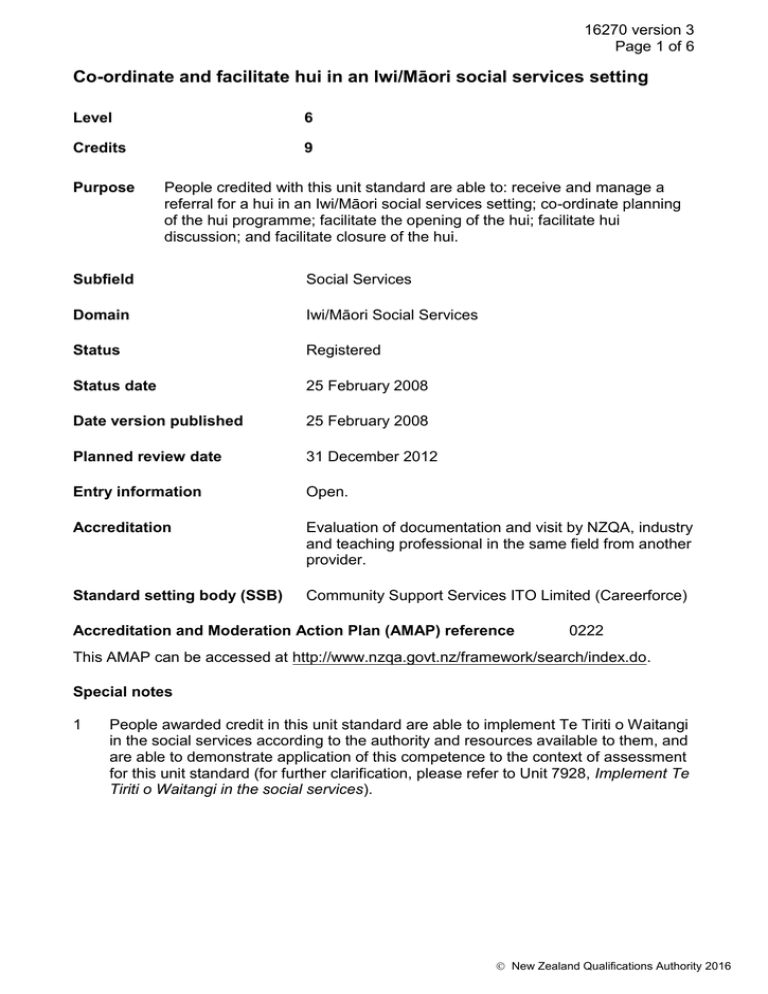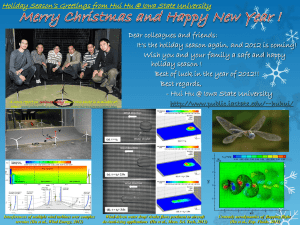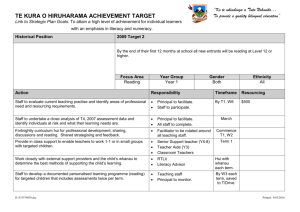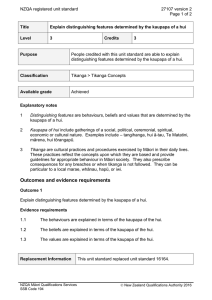ordinate and facilitate hui in an Iwi/Māori social services setting Co-
advertisement

16270 version 3 Page 1 of 6 Co-ordinate and facilitate hui in an Iwi/Māori social services setting Level 6 Credits 9 Purpose People credited with this unit standard are able to: receive and manage a referral for a hui in an Iwi/Māori social services setting; co-ordinate planning of the hui programme; facilitate the opening of the hui; facilitate hui discussion; and facilitate closure of the hui. Subfield Social Services Domain Iwi/Māori Social Services Status Registered Status date 25 February 2008 Date version published 25 February 2008 Planned review date 31 December 2012 Entry information Open. Accreditation Evaluation of documentation and visit by NZQA, industry and teaching professional in the same field from another provider. Standard setting body (SSB) Community Support Services ITO Limited (Careerforce) Accreditation and Moderation Action Plan (AMAP) reference 0222 This AMAP can be accessed at http://www.nzqa.govt.nz/framework/search/index.do. Special notes 1 People awarded credit in this unit standard are able to implement Te Tiriti o Waitangi in the social services according to the authority and resources available to them, and are able to demonstrate application of this competence to the context of assessment for this unit standard (for further clarification, please refer to Unit 7928, Implement Te Tiriti o Waitangi in the social services). New Zealand Qualifications Authority 2016 16270 version 3 Page 2 of 6 2 Assessment notes: This unit standard may be assessed on the basis of evidence of demonstrated performance in the workplace, or through the use of simulated workplace situations that closely approximate the performance required in workplace settings. Workplace settings may include field education placements. Evidence must be obtained from at least two actual workplace situations; or from one actual workplace and one simulated workplace situation. Competence needs to be demonstrated in two service user situations. People awarded credit in this unit standard demonstrate competence in working with service users in an holistic manner according to models of practice within te ao Māori. Service users are responded to in accordance with tikanga practices of te ao Māori and within the Iwi/Māori social services environment in which assessment for this unit standard is taking place. People awarded credit in this unit standard show that their actions through all elements are guided and supported by valid theory for social service practice. Evidence is required of social service theory that is derived from authoritative sources, which may include but are not limited to: body of knowledge related to Iwi/Māori social service work; cultural theory; practice research. Definitions of Māori words will be those relevant and in common usage in an Iwi/Māori social services context. Local iwi or hapū aims and objectives underpin the national standard basis of this unit standard. The definitions of Māori words and concepts in the local dialect must be verified by the local iwi and/or hapū. The context of the unit standard is limited to local rohe or takiwā; where local rohe are also occupied by a number of other iwi or hapū, the tangata whenua or mana whenua view will take precedence. Other iwi or hapū views should be encouraged in order to enrich and enhance understanding of key Māori concepts and practices. Performance of the elements must reflect the roles taken by male and female workers as applicable. Some social services workers facilitate whānau hui under statutory authority. People credited with this unit standard know all pertinent aspects of legislation that is relevant to the assessment context. In the context of this unit standard, relevant legislation may include but is not limited to: Adoption Act 1955, Care of Children Act 2004, Children, Young Persons and Their Families Act 1989, Family Proceedings Act 1980, Mental Health (Compulsory Assessment and Treatment) Act 1992, Protection of Personal and Property Rights Act 1988. 3 Glossary: Characteristics and needs of the participants in the hui may be physical, spiritual, or mental. Characteristics and needs include age and stage of development, culture, disability, family or professional roles, gender, health status, language, sexual orientation, and needs for physical comfort, safety, and privacy. Hui in the context of this unit standard may include but is not limited to a whānau hui, Iwi/Māori social service hui, board meeting. The term social service worker is used in this unit standard to refer to the person seeking credit. Social service workers include but are not limited to: community workers, counsellors, kaiāwhina, social workers, kaitautoko, youth workers, and others who deliver social services; whether paid or unpaid. New Zealand Qualifications Authority 2016 16270 version 3 Page 3 of 6 4 All communications with service users are dealt with according to tikanga practices of te ao Māori and the standards of the Iwi/Māori social services environment in which assessment for this unit standard is taking place. Confidentiality issues are defined through negotiation with service users and their informed consent, and criteria established by service provider guidelines. Other relevant criteria may include but are not limited to: Official Information Act 1982, Privacy Act 1993, service provider codes of conduct, codes of practice issued by the Privacy Commissioner, social service codes of ethics, and service provider staff manuals, strategic plans, kawa, and tikanga. Elements and performance criteria Element 1 Receive and manage a referral for a hui in an Iwi/Māori social services setting. Performance criteria 1.1 Referrals are received and recorded according to contractual agreements and service provider guidelines. 1.2 The service user and other key members for ongoing consultation are identified according to agreement with the service user. 1.3 Referrals are assessed for relevance to the Iwi/Māori social service setting and accepted or diverted according to consultation with the service user and service provider guidelines. 1.4 Referrals are processed through organisational systems in the Iwi/Māori social service setting according to service provider guidelines. Element 2 Co-ordinate planning of the hui programme. Range key stakeholders may include but are not limited to – the service user, the service user’s whānau, service providers. Performance criteria 2.1 Participants in the hui are identified in consultation with key stakeholders. 2.2 The programme is planned in accordance with the goals, objectives, procedures, and time schedules of the participants. 2.3 Co-ordination of planning is carried out according to agreement with key stakeholders. New Zealand Qualifications Authority 2016 16270 version 3 Page 4 of 6 2.4 Co-ordination identifies and communicates to participants any statutory provisions that govern the hui or prescribe any requirements for task or process. 2.5 Co-ordination of planning identifies key factors for the hui programme. Range 2.6 key factors for the hui programme – appropriate venue; kaupapa; kawa for the hui; date; proposed duration of the hui; resources such as kai; budget for hosting; travel and accommodation fares for participants where required. The key roles for the hui are identified according to agreement with key stakeholders and service provider guidelines. Range key roles include – facilitator, kai karanga, kai korero, kai karakia, ringawera. 2.7 Participants who have information essential to the kaupapa of the hui are identified in terms of criteria established by legislation, ethical practice, and service provider guidelines. 2.8 Participants who are to attend are identified and notified of the plan. Element 3 Facilitate the opening of the hui. Performance criteria 3.1 Participants in the hui are welcomed according to the established kawa and any responsibility on the social service worker for aspects of the mihimihi. Range aspects include – karanga, mihimihi, karakia, kai. 3.2 The different roles and functions of participants in the hui are identified according to the nature and purpose of the hui and the characteristics and needs of the participants. 3.3 The participants are assisted to identify and agree upon the kaupapa of the hui, or issues or take to be resolved, and to set objectives. 3.4 The outcomes of any prior discussions with the participants about the kaupapa of the hui are communicated to the hui and agreement is sought. 3.5 Participants who have information essential to the kaupapa of the hui are assisted to make this information available in a manner that acknowledges the characteristics and needs of the other participants in the hui. 3.6 Any statutory provisions that govern the hui or prescribe any requirements for task or process are identified and communicated to participants in the hui through the facilitation process. New Zealand Qualifications Authority 2016 16270 version 3 Page 5 of 6 Element 4 Facilitate hui discussion. Performance criteria 4.1 Facilitation is carried out according to the established kawa and the kaupapa of the hui. 4.2 Facilitation is directed towards assisting the process of the hui, maintaining progress towards achieving agreed objectives, and development of any required plan. 4.3 Facilitation is appropriate to the characteristics and needs of the participants in the hui. 4.4 Facilitation of the hui is in accordance with any statutory requirements on the facilitator, participants in the hui, and the kaupapa of the hui. 4.5 The hui is assisted to work towards consensus agreement on plans to achieve objectives. Element 5 Facilitate closure of the hui. Performance criteria 5.1 The hui is assisted to work towards consensus agreement on outcomes of the hui. 5.2 Any plans are recorded according to agreement with participants in the hui. 5.3 Records include identification of the responsibilities of participants in the hui, including the facilitator, and details of the time, date, and venue of any further hui. 5.4 The hui is closed according to the established kawa and any responsibility on the social service worker for aspects of the closure. Range 5.5 closure – karakia, poroporoaki. Facilitation is carried out in accordance with criteria established by legislation, ethical practice, and service provider guidelines. Please note Providers must be accredited by NZQA, or an inter-institutional body with delegated authority for quality assurance, before they can report credits from assessment against unit standards or deliver courses of study leading to that assessment. New Zealand Qualifications Authority 2016 16270 version 3 Page 6 of 6 Industry Training Organisations must be accredited by NZQA before they can register credits from assessment against unit standards. Accredited providers and Industry Training Organisations assessing against unit standards must engage with the moderation system that applies to those standards. Accreditation requirements and an outline of the moderation system that applies to this standard are outlined in the Accreditation and Moderation Action Plan (AMAP). The AMAP also includes useful information about special requirements for organisations wishing to develop education and training programmes, such as minimum qualifications for tutors and assessors, and special resource requirements. Comments on this unit standard Please contact Community Support Services ITO Limited (Careerforce) info@careerforce.org.nz if you wish to suggest changes to the content of this unit standard. New Zealand Qualifications Authority 2016




